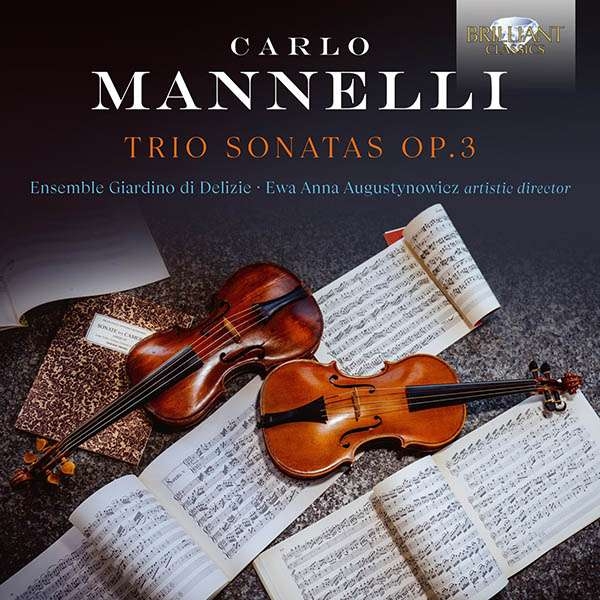Košík
Váš košík je momentálne prázdny.
Mannelli: Trio Sonatas Op. 3 (2CD)
14,00 €
Formát:
CD
Dostupnosť:
7-14 dní
Katalógové číslo:
96465
EAN kód:
5028421964652
Autori:
Carlo Mannelli
Interpreti:
Elisabetta Ferri, Ensemble Giardino di Delizie, Ewa Anna Augustynowycz, Katarzyna Solecka, Sofia Ferri, Valeria Brunelli
Vydavateľ:
BRILLIANT CLASSICS
Zoznam skladieb
CD 11 Sonata No. 4 in A Major, Op. 3, vivace, canzone, adagio, capriccio
2 Sonata No. 5 in B Minor, Op. 3, adagio, non presto, fuga, adagio cantabile, aria allegro, capriccio
3 Sonata No. 7 in D Major, Op. 3, vivace, canzone, adagio, capriccio
4 Sonata No. 9 in E Minor, Op. 3, non presto, lento, adagio, fuga, adagio, aria. largo solo
5 Sonata No. 3 in A Minor, Op. 3, vivace, fuga, adagio, capriccio
6 Sonata No. 8 in E Minor, Op. 3, allegro, vivace, capriccio, adagio assai, canzone allegra, adagio, aria
CD 2
1 Sonata No. 12 in A Minor, Op. 3, allegro, allegro, lento. Smorzi spesso & ondegiato
2 Sonata No. 11 in F Major, Op. 3, adagio-vivace, canzone, adagio, capriccio
3 Sonata No. 1 in G Minor, Op. 3, allegro, allegro, canzona. vivace, adagio, capriccio
4 Sonata No. 10 in F Major, Op. 3, adagio, adagio cantabile, adagio ondegiato forte e piano, allegro
5 Sonata No. 6 in C Minor, Op. 3, cantabile-adagio, aria, adagio, canzone larga, allegro
6 Sonata No. 2 in G Major, Op. 3, allegro, fuga, adagio, capriccio. Non presto
Popis
The forgotten art of a 17th-century Roman master, in the hands of a dynamic period ensemble with a string of acclaimed rarity albums to their credit. The Baroque trio-sonata repertoire still yields up plenty of undiscovered treasure lying in libraries across Italy. The Ensemble Giardino di Delizie has been diving into it and coming up with polished gems on Brilliant Classics by Stradella (96079), Colista (96033) and Lonati (95590). Like Colista, Carlo Mannelli (1640-1697) was Roman by birth and training. He sang and played the violin for ensembles at both church and court, and was permitted to dedicate his Op.2 collection to Cardinal Benedetto Pamphilj. Perhaps it was the patronage of this influential family that opened doors to his training with Michelangelo Rossi, and to distinguished musical societies in Rome. Another noble Roman family was the recipient of Mannelli’s Op.3 collection of trio sonatas, with its dedication to Prince Domenico Rospigliosi. Much of the composer’s output is now lost, and we can only surmise at the riches deprived to us by time, given the fresh melodic invention of what survives here. Compared to Stradella and co, Mannelli cuts an eccentric, highly individual figure, musically speaking, and he has no interest in the orderliness of Corelli. The arrangement of slow and fast movements is unpredictable: the four-movement No. 10 begins with three separate Adagios! The six-movement No.9 cuts a sequence of four slow movements in half with a fugue, and so on. Three of the twelve sonatas feature a ravishing aria for the violin, who takes on a soloist’s role. When Mannelli writes quick music, he pushes his musicians to the limits, as in the finale of the First Sonata. Counterpoint is subordinate to the kind of highly elaborate violin writing at which Ewa Anna Augustynowicz has already shown herself to excel in previous albums, making this new recording an essential acquisition for Baroque-music aficionados. Carlo Mannelli (Rome, 1640-1697) spent the major part of his life in Rome where he also worked during the opera performances and religious events. As a violinist nicknamed Carlo del Violino and Carluccio di Pamfili, he played the first violin in the most famous Roman musical ensembles of the period. Arcangelo Corelli, who often played under Mannelli, described him as one of his most influential teachers. For several years, Mannelli was leader of the famous Congregetione di S. Cecilia. The Trio Sonatas Op.3 consists of twelve Sonatas. Seven of them are in four movements, two are in six movements and only one (the last) is in three movements. They display a freshness of melodic invention and sometimes daring harmonic surprises, a great tonal richness and unexpected, highly expressive chromatic phrases. The ensemble Giardino di Delizie is a Roman female Baroque group, founded in 2014 by the violinist Ewa Anna Augustynowicz, researching and performing forgotten treasures from the Italian and Polish Baroque. They played in such ensembles as Europa Galante, Les Eléments, Quatuor Mosaïques and others. Their previous recordings of instrumental works by Lonati, Stradella, Colista and Leonarda met with enthusiast critical acclaim in the international press: ‘The performance sounds completely natural, full of spontaneity and bursting energy. It’s clear the group really likes this music and does not merely try and lecture it.’ (Lonati, 95590 theclassicreview.com). ‘Giardino di Delizie… take an energetic and imaginative approach to this fine music… playing with sensitivity and considerable musicality.’ (Colista, 96033, earlymusicreview.com). ‘A garden of delights, sensitively and beautifully performed, perfect for any lover of the Baroque.’ (Gems of the Polish Baroque, 95955, MusicWeb International). Prihlásenie
Newsletter



